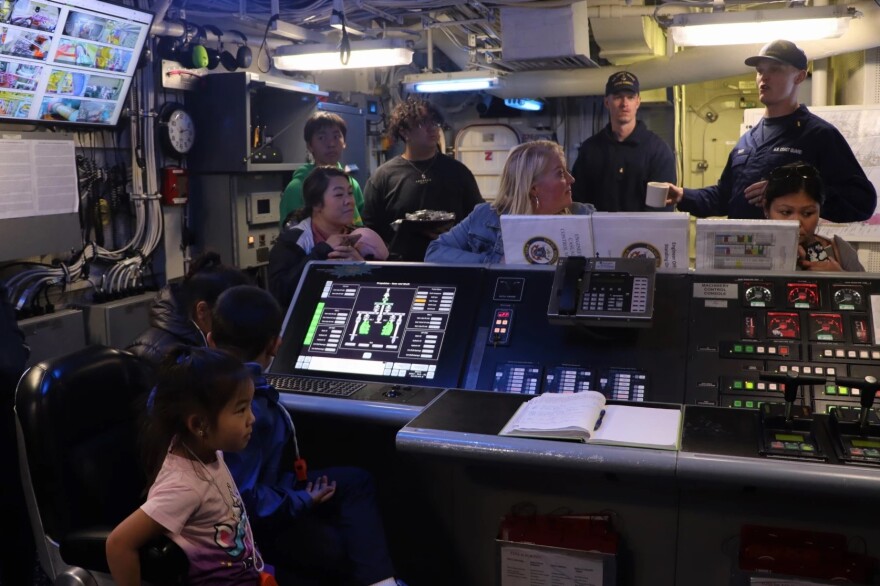The U.S. Coast Guard cutter Kimball calls Honolulu home, but recently it’s seen a lot of action in the Aleutians.
Just last month while on a routine patrol, the vessel encountered a group of seven Russian and Chinese warships traveling together through the Bering Sea. The Kimball’s commander, Capt. Thomas C. D’Arcy, recalled the encounter during a port call in Unalaska last weekend.
“We tracked them from about Kiska Island and then down through the pass,” D’Arcy said, pointing at a map of the Bering Sea. “So I'm assuming that they came up into the Bowers Ridge area and then moved in formation.”
The path the ships took was similar to that of a group of Chinese vessels that the Coast Guard tracked and followed in the region just about a year ago, according to D’Arcy.
The Kimball — which carries about 120 crew members, defensive weapons and a helicopter — came within about a mile of the group and made radio contact with them. Crew members on the foreign warships responded, but never declared who was coordinating the formation, he said.
While the group didn’t break any rules or give reason for direct contact, D’Arcy said the Kimball accompanied the ships until they passed into the Pacific side of the Aleutian Islands, where they split up.
He said they encountered the warships in the Bering Sea, in the U.S. Exclusive Economic Zone — an area up to 200 nautical miles offshore, where the U.S. has jurisdiction over natural resources. The formation never entered U.S. territorial seas.
NATO officials have warnedof a strategic Arctic partnership between Russia and China that challenges the organization's values and interests. For D’Arcy, Russia’s persistence to militarize and develop a presence in the Arctic is concerning. But, he said part of the Coast Guard’s duty is to ensure that the U.S. sovereign interests are protected and to spend more time in the region.
“The most important piece for the Coast Guard is to make sure that we're there and that we're observing what's happening, whether it's a foreign vessel that's coming up to do research or another naval vessel from a different country that's operating in that area, especially if it's anywhere near our interested waters,” D’Arcy said.
On Saturday, the crew of the 418-foot vessel welcomed more than 100 guests for tours, while docked up at Unalaska’s spit.
D’Arcy said he was excited to host the community, especially after about two years of limited interaction with locals due to the COVID-19 pandemic.
“It's great to have the crew interact with the local community,” D’Arcy said. “The Coast Guard's presence has been here since like the 1880s. We've been part of Unalaska. We're not always the same ship or the same crew, but I think being able to demystify what we're doing here was one of the goals that we had for this visit.”
About half of the visitors that boarded the ship throughout the day on Saturday were school-aged kids, he said.
“We had stations out where they could try on gear, ask questions of our specialists — whether that was our cooks or maritime law enforcement specialists,” D’Arcy said. “We had our unmanned aerial surveillance aircraft out.”
D’Arcy said the event is meant to show Unalaskans that the Coast Guard cares about their well being and safety, but it’s also a great chance for the crew to get to know the island community.
“When we say, ‘Hey, we want to do open tours,’ we have more volunteers than needed,” he said. “Everyone was like, ‘Come on, can I wear (my fancy uniform)?’ … They're eager to show what they do. And it makes me proud.”
This is D’Arcy’s second trip to Unalaska, and it’s the Kimball’s second deployment to the state. Right now, the ship is about two months into its roughly three-month station in the area.
D’Arcy didn’t comment on the strategic implications of the foreign warships the Kimball encountered last month. But he said the cutter is staged for just about anything and will continue monitoring the area for foreign military activity.
“Kimball will be ready and respond,” he said. “But if there is no foreign presence and no threat there, no adversarial strategic competitor operating in our waters, then we shift to the next tasking and priority.”
For now, the Kimball will continue patrolling near Unalaska in the Bering Sea region and into the Arctic.
As the fall weather builds and fishing seasons begin picking up, D’Arcy said the crew is preparing for weather-related accidents and enforcement of fishing regulations.





